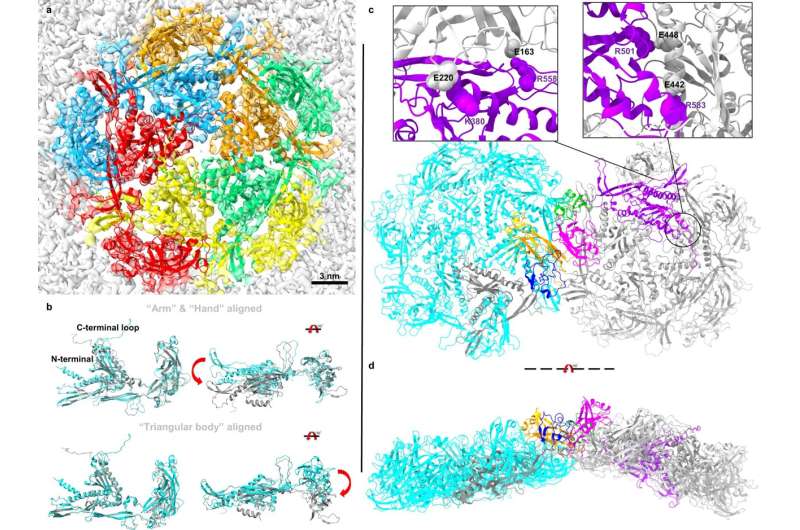Pentamer arrangement in the capsid of ϕKp24. a Top view of a pentameric capsomere. Five gp372 structures were fitted into the density map and colored differently. Compared with the hexamer, the pentamer lacks a structured pore at the center. Each C-terminal loop is flexible, and it tends to move to the area closer to another gp372’s hand. b Structural comparison between the MCP (cyan) in a hexamer and MCP (gray) in a pentamer. There are some differences, such as the C-terminal loop, the N-terminal α helix, and the pendulum angle (upper red arrow) of two triangular bodies (aligned hand and arm), or the pendulum angle (lower red arrow) of two hands (aligned triangular body). The right image in b shows the comparison after rotation of the left structure by 90°. c Pentamer-hexamer interactions. The interactions between a pentamer (gray) and a neighboring hexamer (cyan) are similar to the interactions between two hexamers. The upper left panel shows that the hand (gray) from the clockwise (CW) neighbor can interact with the triangular body (purple) in the same pentamer using salt bridges (residue E220 and K380, E163, and R558). In the pentamer MCP, residues R501 and R583 in the triangular body interact with residues D448 and E442 (the enlarged rectangular box, upper right panel). The gp372 from a hexamer and the gp372 from a pentamer are highlighted by different colors according to the structural units. The triangular body, arm, and hand of the gp372 in hexamer are colored black, deep blue, and orange. The triangular body, arm, and hand of the gp372 in pentamer are colored purple, green, and pink. d Side view of pentamer-hexamer interactions after rotation of the upper image by 90°. Credit: Nature Communications (2022). DOI: 10.1038/s41467-022-34972-5
Bacteriophages, viruses that infect bacteria, may be used as an alternative treatment option when antibiotics fail. Leiden researchers have studied the structure and function of a novel bacteriophage that could be used to treat one of the WHO bacterial strains of concern where new treatments are urgently needed.
A team of Leiden scientists has been researching a bacteriophage that can fight a specific bacterium. The bacterium in question normally resides in our digestive tract and can cause damage if it spreads to other parts of our body. It can then cause various infections, such as pneumonia and urinary infections.
Phage therapy as an alternative to antibiotics
Ariane Briegel (Institute Biology Leiden) and Daan Pelt (Leiden Institute of Advanced Computer Sciences) tell more about the research. "According to the WHO, the bacterium raises concern, because it is increasingly resistant to antibiotics. Phage therapy is a potential alternative to fight bacterial infections when antibiotics are not effective," says Briegel.
That is why it was important for the team to investigate the bacteriophage. Briegel says, "We found out more about the structure and function of the bacteriophage, giving us more insight into how the bacteriophage can infect the pathogen."
Pelt mapped a part of the bacteriophage by using a neural network, an algorithm that learns from examples. "At the tip of the bacteriophage is a complex network of tails that play a role in infecting the bacteria. As of yet, little is known about what these tails look like, because there is a large variety in their structures. Ph.D. student Ruochen Ouyang manually mapped seven of these tail structures. We then trained a neural network on the seven examples, so that we can also distinguish the tail structures for other phages," says Pelt.
'Working together gave us unique insights'
"The collaboration of different disciplines allowed us to get a good insight into various topics," says Briegel. "For example, we looked at which structural components the bacteriophage is made up of. We were supported by a team of experts on bacteriophage tail fibers. Because we collaborated with scientists from different backgrounds, we got unique insights about the bacteriophage. This will hopefully help us answer a large spectrum of biological questions in the future."
The researchers are enthusiastic about this specific bacteriophage. Briegel states, "The problem with phage therapy is that bacteriophages don't work on all bacteria, even from the same species. In contrast to many known bacteriophages, this one is special because it works on many different subtypes. This makes it a good candidate for phage therapy. By learning more about how the bacteriophage works, we can hopefully treat people with it in the future."
The paper, "High resolution reconstruction of a Jumbo bacteriophage infecting capsulated bacteria using hyperbranched tail fibers," is published in Nature Communications.
More information: Ruochen Ouyang et al, High-resolution reconstruction of a Jumbo-bacteriophage infecting capsulated bacteria using hyperbranched tail fibers, Nature Communications (2022). DOI: 10.1038/s41467-022-34972-5
Journal information: Nature Communications
Provided by Leiden University
























